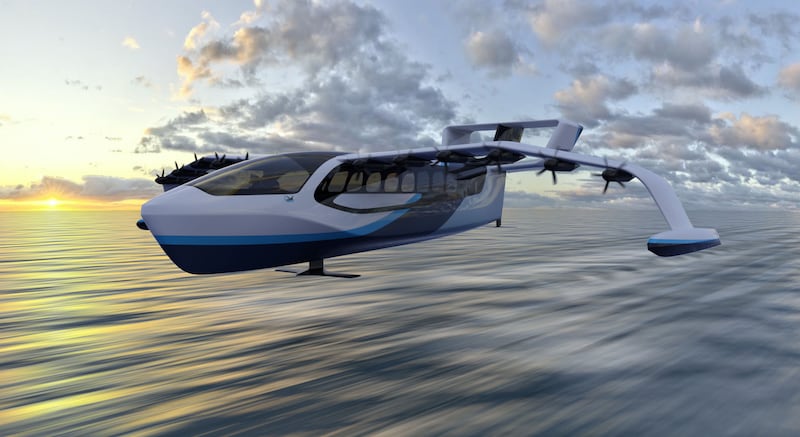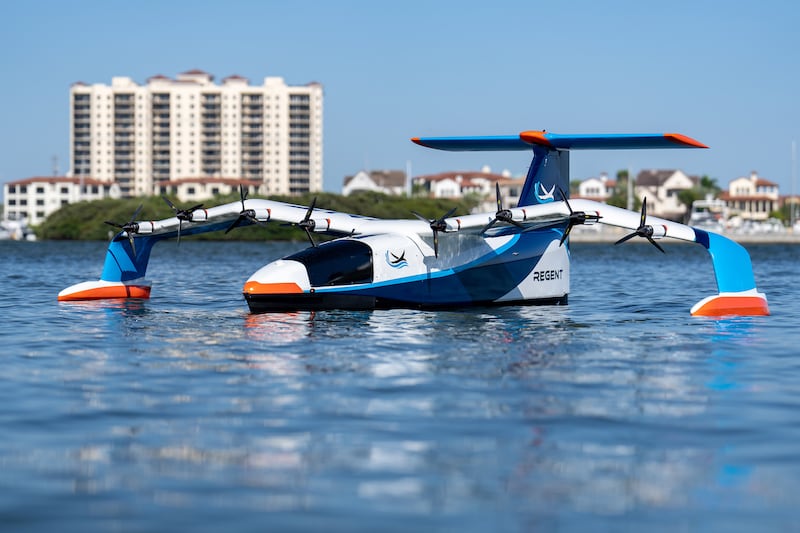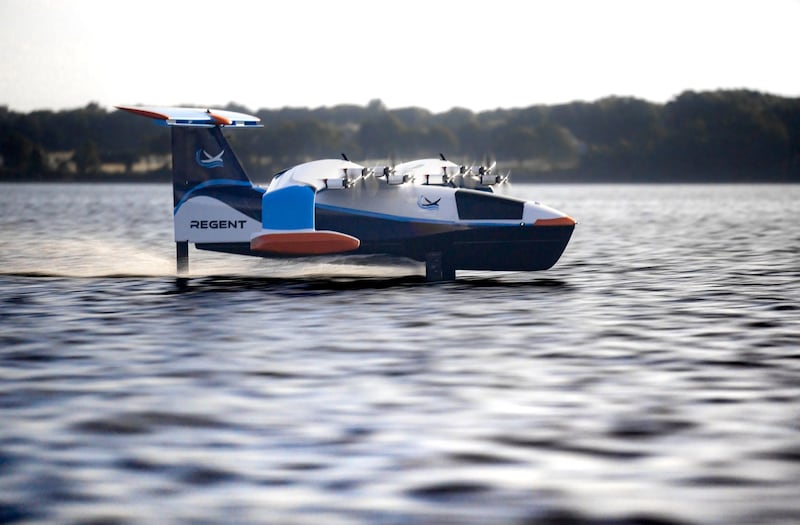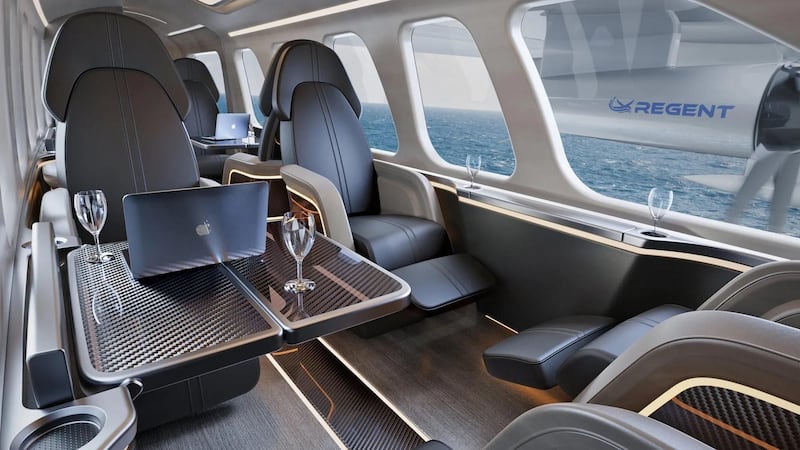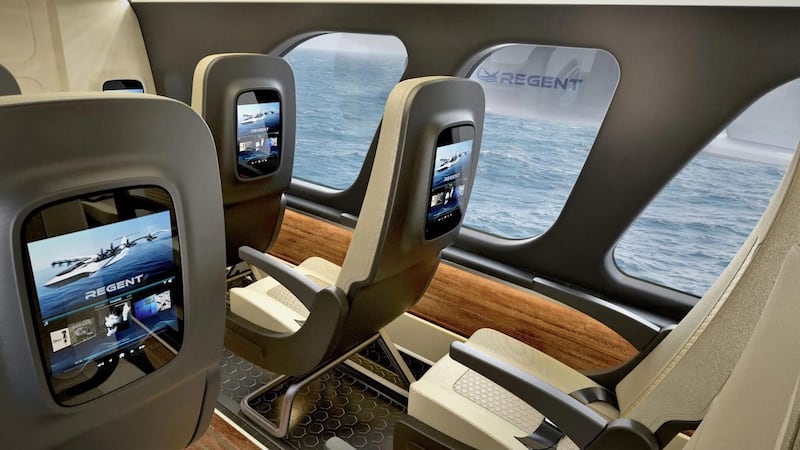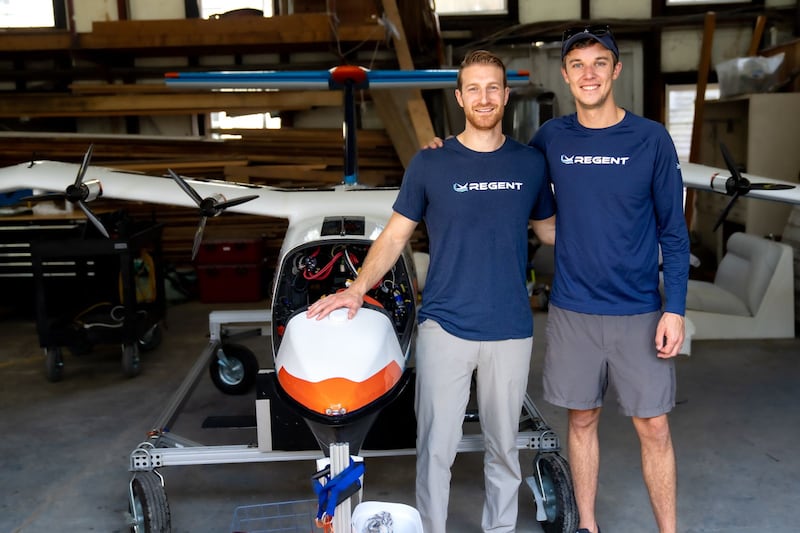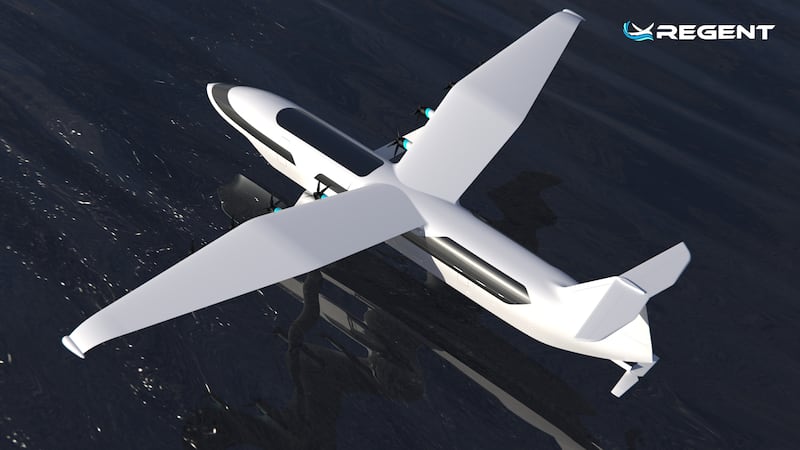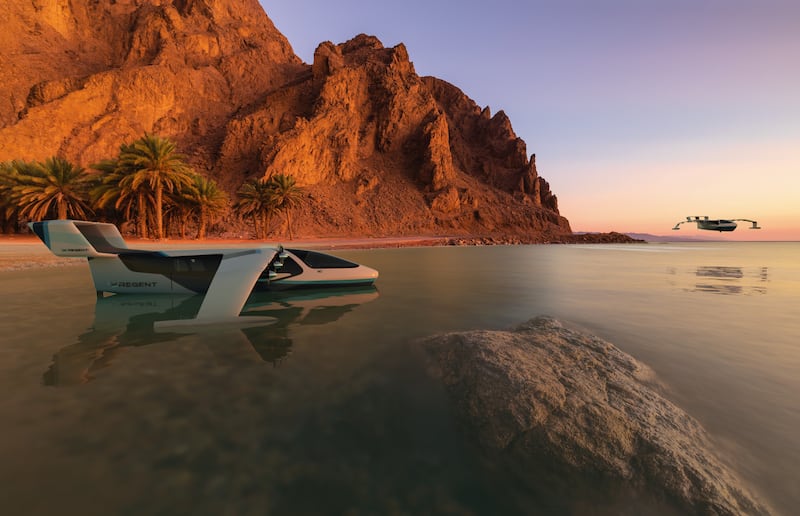Seagliders that travel at high speeds over water will be built in the UAE following the signing of an agreement between the US maritime transport company Regent and Abu Dhabi Investment Office on Thursday.
Boston start-up Regent has also signed an agreement with Abu Dhabi's Department of Transport to integrate its electric-powered seaglider into the existing UAE transportation network, with a focus on high-impact routes, such as offshore services to Delma Island and Sir Bani Yas Island.
Regent is in the development stages of its passenger craft, Viceroy, which uses wing-in-ground effect to travel at speeds of up to 290kph within a wingspan of the water's surface, cutting travel times between coastal cities by more than half.
The company, which has demonstrated its float, foil and fly technology in testing on a quarter-scale model, is now building a full-scale 20-metre wingspan model capable of carrying 12 passengers and two crew to test its use before going into full production next year at its base in Rhode Island.
Regent has had significant support from the industry and investors in raising its $60 million Series A Funding, including Abu Dhabi's Strategic Development Funds and Neom Investment Fund, which made the single largest investment in the round.
There has also been backing from Japan Airlines, Hawaiian Airlines, Lockheed Martin and Shark Tank star and billionaire Mark Cuban, with total investment now standing at $90 million.
Co-founder and chief executive Billy Thalheimer said Regent also has a backorder of more than $9 billion from airline and ferry operators for both the Viceroy craft and the larger 100-passenger Monarch, which he expects will transform regional transport for coastal areas.
Regent has manufacturing and test facilities in Rhode Island and is "looking at other sites within the US" to develop its building capacity, Mr Thalheimer told The National.

To help meet orders in the Middle East, Europe and Indo-Pacific regions, Regent will "localise sea glider manufacturing in Abu Dhabi", he said.
"We’re working right now with Adio on the plan. Our intention is to establish manufacturing by the end of the decade," he said.
"The next step is to pull in all the relevant players, do site identification, manufacturing readiness and figure out what the whole plan looks like as to when can we start and what manufacturing will entail in Abu Dhabi."
Regent will be part of the Smart and Autonomous Vehicles Industry (Savi) cluster, located in Masdar City, which aims to develop smart and self-driving vehicles for air, land and sea use.
Established as a multi-modal hub in October, Savi is expected to contribute between Dh90 billion and Dh120 billion ($24.5 billion to $32.7 billion) to the UAE's economy and generate up to 50,000 jobs.
Badr Al Olama, the director general of Adio, said Regent will "shape the future of coastal transportation".
"With immense speed and efficiency, I’m confident Abu Dhabi will see the global deployment of electric seagliders and these will dramatically change how goods and people move between the world’s coastal areas going forward," Mr Al Olama said in a news release on Thursday.
Production capacity will depend on demand, but Regent already has firm orders from an unnamed Abu Dhabi-based commercial operator and another in Egypt.
Final details on what will be built in Abu Dhabi are still being thrashed out, he said, but the plan is to have full production facilities in the emirate.
"What we're manufacturing is still part of the discussion," Mr Thalheimer said.
"The intention is to manufacture something but the goal would be full seagliders, and the next step is really figuring out what it actually looks like, putting the nuts and bolts of the details of the deal together."
Fly like a bird

Wing-in-ground effect technology has been around for more than 60 years and is based on using aerodynamic lift plus air pressure generated by flying close to the water surface – the same principle that allows gulls to glide low over the water.
Regent’s seaglider is designed with an intermediary position between boat and glider, popping up on a hydrofoil, allowing it to navigate busier waterways and inclement weather.
Once it has motored out of a harbour on a hydrofoil, the seaglider takes off at a low speed using the water as a runway, then flies over the waves at a top speed of 290kph.
It allows for quick access around coastal waters, particularly from islands to mainland, and is capable of serving routes of up to 300km with existing battery technology and 800km with next-gen batteries.
Abu Dhabi's Department of Transport, in an agreement announced at the DriftX event on Thursday, will integrate the use of seagliders in the emirate, starting with Delma Island, where 10,000 residents mainly use a once-daily flight to access services on the mainland, and Sir Bani Yas Island, home to a protected wildlife reserve and the Desert Islands Resort & Spa by Anantara.
"Currently, it’s [Delma] serviced by Q400 turbo props with one flight a day," Mr Thalheimer said.
"You can imagine how inconvenient it is to have to take an aircraft which only goes once a day to leave your home to access economic opportunities, education, medical care. Seagliders increase the flexibility and access to the mainland for those on Delma Island."
Smart plans
Abu Dhabi has been working on providing residents with smarter, more efficient modes of transport.
In February, Abu Dhabi and Shenzhen signed a twin-city agreement to share knowledge and collaborate on smart city projects across several areas including infrastructure, city planning, green mobility, transport, advanced technology, autonomous solutions, sustainability and urban development.
Abu Dhabi is also trialling driverless taxis in the emirate, while flying taxis are expected to hit Abu Dhabi and Dubai skies next year, cutting travel times significantly between the two emirates.
Mr Thalheimer said the seagliders will also help with inter-emirate connectivity and offer commuters an option to avoid busy motorways between Abu Dhabi and Ras Al Khaimah.
"Right now, if you look at Abu Dhabi to Ras Al Khaimah, you're talking about a two and a half hour drive, at best. But [with seagliders] you will be able to do day trips and can do that trip in under an hour.
"It’s sort of like a Gulf Metro that seagliders would create here, which the DoT can operate."
The trip between Abu Dhabi and Dubai is one of the busiest road journeys in the UAE. Offering high-speed connections on water between the two cities would cut travel times by more than half.
"Seaglider would be about equal on that route. It would be a little faster than a car because you’re moving faster but obviously a car goes door to door but the seaglider has to go to the dock first.
"It would be about 25 minutes in terms of the voyage itself. So we can cut the travel time in half."
In December, Regent signed an agreement with Aramex, the Middle East's largest courier firm, to develop electric seagliders for middle-mile logistics.
It is also working with Saudi Arabia's Neom project to provide connectivity around the islands along the coastline, particularly Sindalah.
"Neom is looking for better connectivity – faster, cheaper, greener, more comfortable connectivity throughout the islands of the Red Sea," he said.
Of particular interest for airlines and ferry operators is the Monarch, which Mr Thalheimer said will enter into service "before the end of the decade".
"All of this technology, the ground effect even the hydrodynamics of the hydrofoil scales really well with size," he said.
"Aircraft flying at altitude, the bigger they get, the heavier they get, the more energy intensive they get, the harder it is to fly large aircraft with batteries."
He said ground effect offers an efficient form of flying that gives it a distinct advantage over aircraft.
"Always being over a place to land is very efficient in terms of how much reserve fuel you need to carry and the hydrodynamic scale very well with size," he said.
"You're talking 50 per cent reduction in operating costs, which ostensibly all gets passed on to the customer as savings by going to seagliders and by going to that large Monarch variant."
